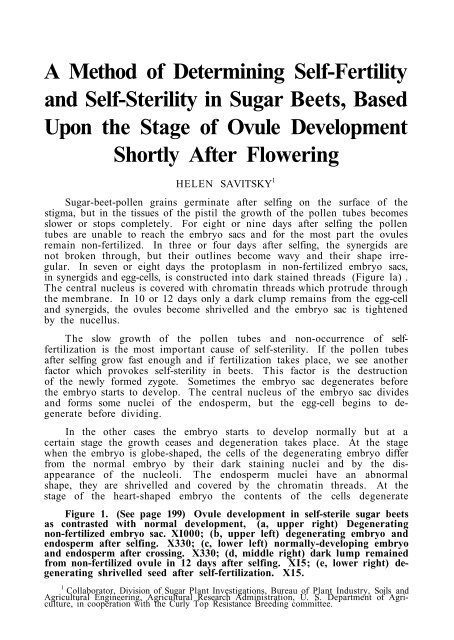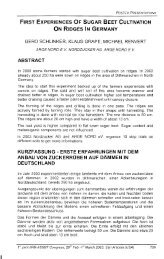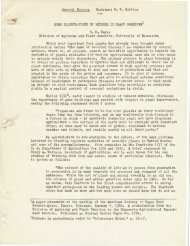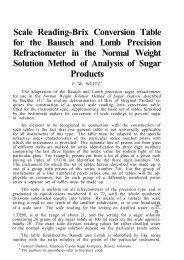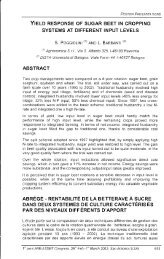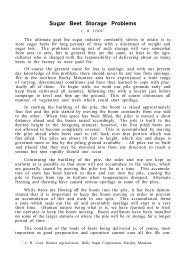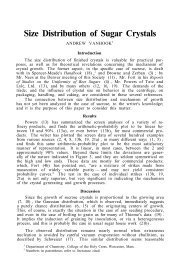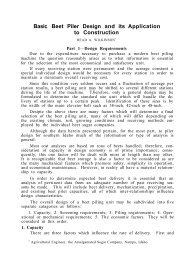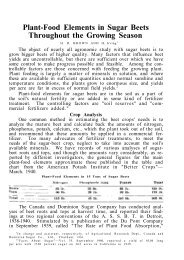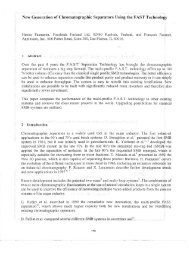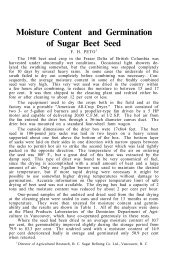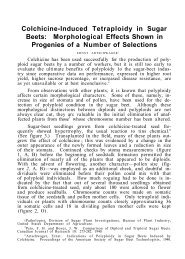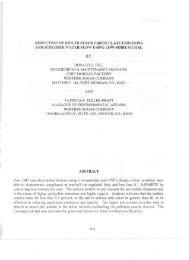A Method of Determining Self-Fertility and Self-Sterility in Sugar ...
A Method of Determining Self-Fertility and Self-Sterility in Sugar ...
A Method of Determining Self-Fertility and Self-Sterility in Sugar ...
Create successful ePaper yourself
Turn your PDF publications into a flip-book with our unique Google optimized e-Paper software.
A <strong>Method</strong> <strong>of</strong> <strong>Determ<strong>in</strong><strong>in</strong>g</strong> <strong>Self</strong>-<strong>Fertility</strong><br />
<strong>and</strong> <strong>Self</strong>-<strong>Sterility</strong> <strong>in</strong> <strong>Sugar</strong> Beets, Based<br />
Upon the Stage <strong>of</strong> Ovule Development<br />
Shortly After Flower<strong>in</strong>g<br />
HELEN SAVITSKY 1<br />
<strong>Sugar</strong>-beet-pollen gra<strong>in</strong>s germ<strong>in</strong>ate after self<strong>in</strong>g on the surface <strong>of</strong> the<br />
stigma, but <strong>in</strong> the tissues <strong>of</strong> the pistil the growth <strong>of</strong> the pollen tubes becomes<br />
slower or stops completely. For eight or n<strong>in</strong>e days after self<strong>in</strong>g the pollen<br />
tubes are unable to reach the embryo sacs <strong>and</strong> for the most part the ovules<br />
rema<strong>in</strong> non-fertilized. In three or four days after self<strong>in</strong>g, the synergids are<br />
not broken through, but their outl<strong>in</strong>es become wavy <strong>and</strong> their shape irregular.<br />
In seven or eight days the protoplasm <strong>in</strong> non-fertilized embryo sacs,<br />
<strong>in</strong> synergids <strong>and</strong> egg-cells, is constructed <strong>in</strong>to dark sta<strong>in</strong>ed threads (Figure la) .<br />
The central nucleus is covered with chromat<strong>in</strong> threads which protrude through<br />
the membrane. In 10 or 12 days only a dark clump rema<strong>in</strong>s from the egg-cell<br />
<strong>and</strong> synergids, the ovules become shrivelled <strong>and</strong> the embryo sac is tightened<br />
by the nucellus.<br />
The slow growth <strong>of</strong> the pollen tubes <strong>and</strong> non-occurrence <strong>of</strong> selffertilization<br />
is the most important cause <strong>of</strong> self-sterility. If the pollen tubes<br />
after self<strong>in</strong>g grow fast enough <strong>and</strong> if fertilization takes place, we see another<br />
factor which provokes self-sterility <strong>in</strong> beets. This factor is the destruction<br />
<strong>of</strong> the newly formed zygote. Sometimes the embryo sac degenerates before<br />
the embryo starts to develop. The central nucleus <strong>of</strong> the embryo sac divides<br />
<strong>and</strong> forms some nuclei <strong>of</strong> the endosperm, but the egg-cell beg<strong>in</strong>s to degenerate<br />
before divid<strong>in</strong>g.<br />
In the other cases the embryo starts to develop normally but at a<br />
certa<strong>in</strong> stage the growth ceases <strong>and</strong> degeneration takes place. At the stage<br />
when the embryo is globe-shaped, the cells <strong>of</strong> the degenerat<strong>in</strong>g embryo differ<br />
from the normal embryo by their dark sta<strong>in</strong><strong>in</strong>g nuclei <strong>and</strong> by the disappearance<br />
<strong>of</strong> the nucleoli. The endosperm muclei have an abnormal<br />
shape, they are shrivelled <strong>and</strong> covered by the chromat<strong>in</strong> threads. At the<br />
stage <strong>of</strong> the heart-shaped embryo the contents <strong>of</strong> the cells degenerate<br />
Figure 1. (See page 199) Ovule development <strong>in</strong> self-sterile sugar beets<br />
as contrasted with normal development, (a, upper right) Degenerat<strong>in</strong>g<br />
non-fertilized embryo sac. XI000; (b, upper left) degenerat<strong>in</strong>g embryo <strong>and</strong><br />
endosperm after self<strong>in</strong>g. X330; (c, lower left) normally-develop<strong>in</strong>g embryo<br />
<strong>and</strong> endosperm after cross<strong>in</strong>g. X330; (d, middle right) dark lump rema<strong>in</strong>ed<br />
from non-fertilized ovule <strong>in</strong> 12 days after self<strong>in</strong>g. XI5; (e, lower right) degenerat<strong>in</strong>g<br />
shrivelled seed after self-fertilization. X15.<br />
1 Collaborator, Division <strong>of</strong> <strong>Sugar</strong> Plant Investigations, Bureau <strong>of</strong> Plant Industry, Soils <strong>and</strong><br />
Agricultural Eng<strong>in</strong>eer<strong>in</strong>g, Agricultural Research Adm<strong>in</strong>istration, U. S. Department <strong>of</strong> Agriculture,<br />
<strong>in</strong> cooperation with the Curly Top Resistance Breed<strong>in</strong>g committee.
PROCEEDINGS—SIXTH GENERAL MEETING 199<br />
Figure 1.
200 AMERICAN SOCIETY OF SUGAR BEET TECHNOLOGISTS<br />
(Figure lb) . The endosperm tissue is represented by a trace <strong>of</strong> demolished<br />
cells. In some ovules the embryo degenerates after hav<strong>in</strong>g formed the seedleaves.<br />
The seed leaves or cotyledons are curved <strong>and</strong> the root has a defective<br />
shape. The embryo cells are empty, <strong>in</strong> many places the cell membrane<br />
beg<strong>in</strong>s to degenerate. Simultaneously with the degeneration <strong>of</strong> the embryo<br />
sac, the ovule also degenerates. It becomes wr<strong>in</strong>kled <strong>and</strong> contracted<br />
<strong>and</strong> the seed coat is pressed <strong>in</strong>. The germ<strong>in</strong>ation ability <strong>of</strong> selfed seeds<br />
is <strong>of</strong>ten very poor. This is caused by the death <strong>of</strong> the embryo <strong>and</strong> the<br />
absence <strong>of</strong> normal seeds <strong>in</strong> the developed seed-ball. Destruction <strong>of</strong> the<br />
embryo is the earliest manifestation <strong>of</strong> the degeneration process caused by<br />
genes which have a lethal action <strong>in</strong> the homozygote after self<strong>in</strong>g.<br />
The rate <strong>of</strong> pollen-tube growth depends on the degree <strong>of</strong> self-fertility<br />
<strong>of</strong> the plant. The lower the percent <strong>of</strong> the fertilized ovules on the plant, the<br />
slower is the growth rate <strong>of</strong> pollen tubes, <strong>and</strong> the later the fertilization<br />
<strong>and</strong> the embryo development. We observed that <strong>in</strong> the highly self-fertile<br />
group nearly one-half <strong>of</strong> the plants (41.7%) were fertilized dur<strong>in</strong>g the first<br />
day <strong>and</strong> one-half (50.1%) on the second day after self<strong>in</strong>g. Most <strong>of</strong> the<br />
partially self-fertile plants were fertilized on the second day after self<strong>in</strong>g<br />
(89.6%) . In poorly self-fertile plants the growth <strong>of</strong> the pollen tubes is so<br />
slow that none <strong>of</strong> them were fertilized the first day <strong>and</strong> nearly half <strong>of</strong> the<br />
plants <strong>of</strong> this group (46.2%) were not fertilized for three days. Thus the<br />
rate <strong>of</strong> pollen-tube growth is associated with the degree <strong>of</strong> self-fertility. In<br />
some highly self-fertile plants the pollen tubes grow with the same rapidity<br />
by self<strong>in</strong>g as by cross<strong>in</strong>g, but to produce a normal set <strong>of</strong> seeds the self-fertile<br />
plants must also possess the ability for normal development <strong>of</strong> the embryo<br />
(Figure 1c.)<br />
Highly self-fertile plants may arise <strong>in</strong> populations as a consequence<br />
<strong>of</strong> mutation <strong>of</strong> a gene which provokes a high rate <strong>of</strong> pollen-tube growth<br />
after self<strong>in</strong>g <strong>and</strong> a comb<strong>in</strong>ation <strong>of</strong> these genes with such genotypes as can<br />
undergo self-fertilization without degeneration <strong>of</strong> embryos. Partially selffertile<br />
races may manifest different degrees <strong>of</strong> both <strong>of</strong> these processes. A<br />
poor degree <strong>of</strong> self-fertility could be caused either by the lack <strong>of</strong> selffertilization<br />
or by the death <strong>of</strong> the embryos. When self-fertile races are<br />
<strong>in</strong>volved <strong>in</strong> breed<strong>in</strong>g processes, it may <strong>of</strong>ten be necessary to determ<strong>in</strong>e the<br />
degree <strong>of</strong> self-fertility <strong>of</strong> a plant dur<strong>in</strong>g the time <strong>of</strong> its flower<strong>in</strong>g. A simple<br />
method, based upon the stage <strong>of</strong> ovule development shortly after flower<strong>in</strong>g,<br />
can be used to determ<strong>in</strong>e the degree <strong>of</strong> self-fertility. Non-fertilized ovules<br />
appear <strong>in</strong> 10-12 days after open<strong>in</strong>g <strong>of</strong> the flower as small, dark lumps on<br />
the bottom <strong>of</strong> the exp<strong>and</strong>ed cavity <strong>of</strong> the ovary (Figure 1d) . The ovules<br />
which have started to develop after self<strong>in</strong>g, but <strong>in</strong> which the embryos have<br />
degenerated, appear as large but shrivelled seeds with<strong>in</strong> the cavity <strong>of</strong> the<br />
ovary (Figure le) .<br />
The branches <strong>of</strong> a plant <strong>in</strong>tended for <strong>in</strong>vestigation must be bagged.<br />
The buds must be <strong>in</strong>vestigated <strong>in</strong> the summertime 10 to 12 days after they<br />
have f<strong>in</strong>ished flower<strong>in</strong>g. The ovary must be opened <strong>and</strong> determ<strong>in</strong>ations<br />
made <strong>of</strong> percentage <strong>of</strong> (a) small dark ovules, (b) normal develop<strong>in</strong>g seeds<br />
<strong>and</strong> (c) shrivelled seeds. The percent <strong>of</strong> small dark ovules on the bottom<br />
<strong>of</strong> the ovary shows the percent <strong>of</strong> non-fertilized ovules <strong>and</strong> the percent <strong>of</strong><br />
self-sterility <strong>of</strong> the race. In highly self-sterile plants almost all ovules appear<br />
as small dark lumps. The percent <strong>of</strong> normally developed seeds <strong>in</strong>dicates
PROCEEDINGS—SIXTH GENERAL MEETING 201<br />
the degree <strong>of</strong> self-fertility <strong>of</strong> the plant. In highly self-fertile races almost all<br />
ovules are large, non-shrivelled <strong>and</strong> fill the cavity <strong>of</strong> the ovary. The amount<br />
<strong>of</strong> large but shrivelled seeds shows the amount <strong>of</strong> fertilized but dead ovules.<br />
They must be added to the amount <strong>of</strong> normally developed seeds to determ<strong>in</strong>e<br />
the degree <strong>of</strong> self-fertilization <strong>of</strong> the plant. At the same time percentage <strong>of</strong><br />
shrivelled seeds <strong>in</strong>dicates the amount <strong>of</strong> degenerat<strong>in</strong>g embryos <strong>and</strong> the <strong>in</strong>fluence<br />
<strong>of</strong> the second factor which provokes self-sterility. The degree <strong>of</strong><br />
self-fertility or self-sterility <strong>of</strong> a plant can be established quickly <strong>and</strong> easily<br />
on the basis <strong>of</strong> this analysis. Then the plant <strong>in</strong>vestigated <strong>in</strong> this manner<br />
can be used for cross<strong>in</strong>g or self<strong>in</strong>g.<br />
Summary<br />
<strong>Self</strong>-sterility <strong>in</strong> beets is caused by: absence <strong>of</strong> self-fertilization because<br />
<strong>of</strong> slow rate <strong>of</strong> pollen-tube growth, <strong>and</strong> degeneration <strong>of</strong> embryos after<br />
self<strong>in</strong>g. Non-fertilized ovules appear <strong>in</strong> 10-12 days after open<strong>in</strong>g <strong>of</strong> flower<br />
as small dark lumps on the bottom <strong>of</strong> the exp<strong>and</strong>ed cavity <strong>of</strong> the ovary.<br />
Determ<strong>in</strong>ation <strong>of</strong> the degree <strong>of</strong> self-sterility or self-fertility is based upon<br />
exam<strong>in</strong>ation <strong>of</strong> ovules dur<strong>in</strong>g the time <strong>of</strong> flower<strong>in</strong>g <strong>of</strong> the plants.


